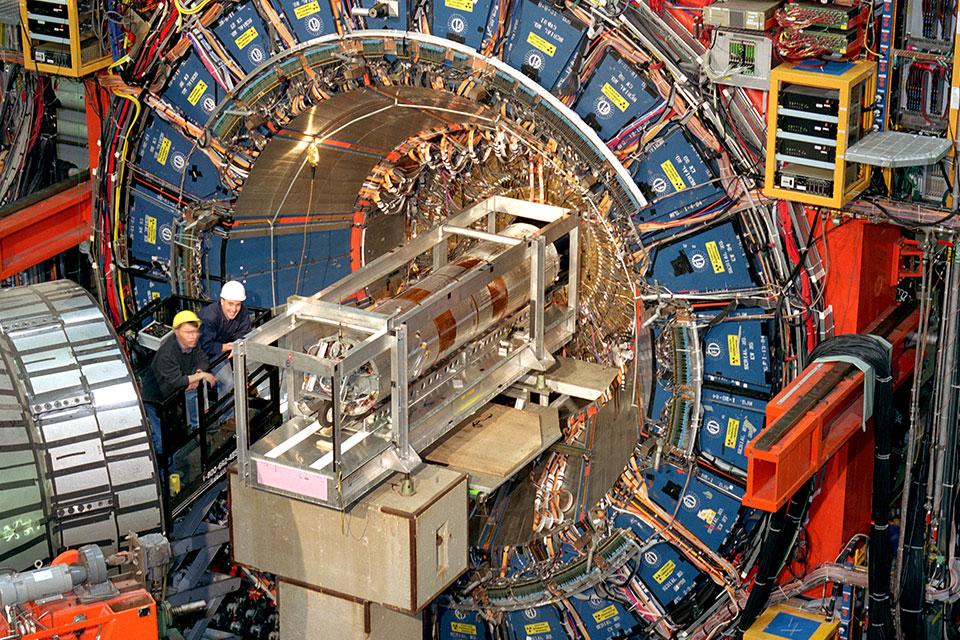A team of scientists have performed the world's most precise measurement of the mass of the force-carrying W boson, which is responsible for nuclear decay and fusion reactions in the sun. The measurement, led in part by Oxford's Professor Chris Hays, found the W boson to be significantly heavier than the prediction of the Standard Model of particle physics, suggesting the existence of new unknown interactions involving the W boson.
The Standard Model describes the interactions of 12 distinct matter particles through the exchange of four force-carrying vector bosons and the Higgs boson. The W boson carries the weak force and plays a special role in the model, as it is the only particle that can change one matter particle into another. This allows for such processes as nuclear fission and fusion. The theory underpinning the Standard Model predicts that the W boson should be massless, a mystery that was solved in the 1960s when Peter Higgs and others realised that a new scalar boson would allow for massive vector bosons. The predicted Higgs boson was discovered at the Large Hadron Collider (LHC) in 2012. Precise measurements of the W boson mass test for the presence of additional unknown particles, through the effects of quantum fluctuations.
The new measurement used data collected by the Collider Detector at Fermilab (CDF) during the Tevatron's 2003-2011 production of proton-antiproton collisions at a centre of mass energy of 2 Tera electron volts. The Tevatron, a predecessor to the Large Hadron Collider (LHC), consisted of a 6.3 km circular accelerating ring in Batavia, Illinois, and produced important physics results such as the discovery of the top quark, the first observation of the oscillation of the Bs meson, and the first hadron-collider constraints on Higgs boson production prior to its discovery at the LHC.
Ten years of data analysis
The W boson mass measurement exhibited meticulous precision, at the level of 0.01%, and required more than ten years of data analysis. A pillar of the measurement is the calibration of the charged-lepton momentum, which is based on the known decays of the J/psi and Upilon mesons and is transferred to the measurement using decays of Z and W bosons. The calibration was tested by performing the highest-precision Z boson mass measurement at a hadron collider, with a result that is consistent with the more precise determination from the Large Electron Positron collider (LEP).
Following the successful calibration of the charged leptons, the measurement team performed additional calibrations specific to the W-boson measurement before finally uncovering the result. Describing the procedure, Professor Hays said, ‘The CDF measurement was performed over the course of many years with the measured value hidden from the analysers until the procedures were fully scrutinised. When we uncovered the value, it was a surprise.’
Challenging the Standard Model
The measurement deviates from the Standard Model prediction by 77 +- 11 MeV/c^2, well above the accepted significance of 5 standard deviations for a "discovery." However, the measurement also deviates from other precise measurements at the LHC and the Tevatron, and further investigation is required to shed light on the discrepancies.
Professor Ian Shipsey, Head of the Department of Physics at Oxford, adds: 'My colleague Chris Hays is an extraordinarily careful physicist. As a member of both CDF and the ATLAS experiment at the Large Hadron Collider which made another of the precise measurements of the W boson mass, he is extremely well-placed to lead the team that now compares these two results to help understand the discrepancy between them.'
The CDF collaboration consists of approximately 400 physicists from 23 countries, including fellow Oxford collaborators Daniela Bortoletto, Peter Renton, and Farrukh Azfar. Many Oxford students and research associates contributed to the data collection and analysis over the CDF experiment's lifespan, as well as Oxford physicists Jeff Tseng and Todd Huffman, who have since moved on to other experiments. According to Professor Renton, who worked on a previous iteration of the measurement, the new measurement is ‘a very important test of the Standard Model, which gives a highly constrained and precise prediction of the W boson mass. The difference of this from the new measurement gives the intriguing suggestion of new physics beyond the Standard Model.’
High-precision measurement of the W boson mass with the CDF II detector, CDF Collaboration, Science, 7 April 2022 Vol 376, Issue 6589
Mass of rare particle may conflict with 'standard model' signalling new physics, Adrian Cho, Science

